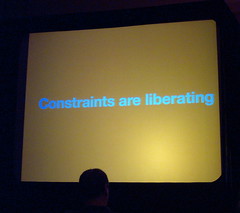Richard Kilmer (from InfoEther, right in my backyard!) gave an amazing presentation/demo on ActionStep. He even took the time late last night/ealry this morning to build a demo with a Ruby on Rails back-end. Here are my notes from the session:
ActionStep: OSS Component for Flash
Motivations:
- cross-platform user-experience
- full widget model
- small core, plugin arch
- themable at runtime
- open source (like)
- driven remotely by ruby
Why Flash?
- proprietary but
- published spec
- pervasive runtime
- good technology
- stack based
- ActionScript programmability
- Networking
- Animation Engine
- MTASC (open source ActionScript compiler)
State of Flash
- Flash 7 (8 on 8/8/05)
- ActionScript 2.0: ECMAScript (packages, classes, interfaces)
- Components 2.0: AS 2.0 based, source w/IDE, remoting, themable
- Flex (declarative, server oriented tech)
What’s in a swf?
- Library (movies, bitmaps, fonts, sounds, vector graphics). Flash IDE/swfmill can be used to build this.
- Frames/Timeline
- ActionScript bytecode. Use MTASC to compile it.
- Components are hybrid — use both vector graphics and ActionScript
Houston, we have a problem …
- In flash everything is a movie clip
- sub-clips have access to the root’s library, but other movie clips with their own libraries override the parent library!
- the ActionScript bytecode is always shared across clips
- if a plugin contains assets (library) it would override the root library (which was planned to contain the theme for the app), so the plugins would have to carry along their own copy of the theme.
Build a UI toolkit?
- many existing examples are out there (MFC, Swing, SWT, WxWigets, etc)
- chose NextStep > OpenStep > Cocoa
- Why? Because it is a published API (GNUStep open source impl available)
- Well thought through widget model: Views & Cells, Targets & Actions, Responder chain
- Multiple impls (Cocoa, GNUStep, etc)
- Inheritance has good delegation model
- Utilizes dynamic runtime features
Introducing ActionStep
- ActionScript 2.0 implementation for writing RIA
- Foundation and AppKit
- Open Source (BSD license)
- Direct port of OpenStep AppKit (NS* classes)
- Pure ActionScript 2.0 (MTASC compiled)
- All components are drawn (isolated in theme)
- Match method naming
ActionStep Status
- pretty substantial API
Demo
- many different types of components available (sliders, windows, buttons, calendar, textfields, split views, etc).
- very easy to skin components
- no bitmaps, everything is vector graphics in demo
Roadmap:
1.0 by end of year
- End of August for first alpha
- End of Oct for beta
Web stack integration
- Open source Flash-remoting + Ruby on Rails
- Dynamic serialized UI descriptors
- Target / Action, Delegates –> controllers
Rails Integration with ActionStep example
- views build up components
- button clicks call methods back on controllers with params
- controller sends data to the ActionStep view to render the data
Demo #2
- ActionStep with a Rails back-end (last minute demo hacked up late last night/early this morning! No previous experience with Rails, amazing)
- Launches against webrick and a flash window appears with a listbox and button.
- Button click calls back on Rails and prints results to console (not back to ActionStep just yet).
- RIA bound to Rails. Working on bi-directional events
ActionStep website. Slides will be posted soon.
